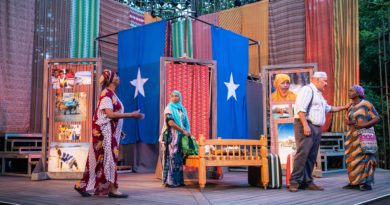Yvonne Ng’s new work “Wéi” explores connection, disconnection and becoming through dance

This July has been a month of firsts for choreographer Yvonne Ng. Ng, the Artistic Director of tiger princess dance projects and the dance: made in canada/fait au Canada festival, had two world premieres this month at Native Earth Performing Arts’ Aki Studio. Both shows feature original music by composer Nick Storring with whom Ng has been collaborating closely since 2013.
Ng’s first show, Sleeping, Tucked in the Lonely Purple, premiered at the 2022 Toronto Fringe show two weeks ago. The work expresses the lived experiences of three senior artists and explores the questions Where or in what time and space does identity reside? and If we are all given the same map, would we arrive at the same destination?
Her second show Wéi is currently on stage until July 31. Wéi means “to become” in Mandarin and is also a play on the homograph, as wèi also means “why”. The work explores how a contemporary dance quintet (Morgyn Aronyk-Schell, Johanna Bergfelt, Irvin Chow, Mairead Filgate and Kathia Wittenborn) can “write” a cohesive story on stage which begins with two questions: What makes us who we are? When do we become us? These questions yield new ones: Is it memory (biological) or is it imitation (experience)? Or is it all preordained and is our fate set? How do we connect? How do we know when we’ve made connection? These questions spark yet another: When do we become us? These inquiries and process shaped the creation of Wéi, and the work explores themes of self-knowledge, identity, the determinants of self, and the connections between individuals.
Ng is of Peranakan Chinese heritage and emigrated to Canada from Singapore. Art is the medium through which she examines her relationship with her place in Canada. Through Wéi, Ng explores the questions, What makes us who we are? and How do we know when we become ourselves?. Just ahead of Wéi’s premiere at Aki Studio, Ng took time for a conversation about the genesis of the work, her intent for the work to reveal and illustrate connection and disconnection, and the visceral excitement that Wéi offers through the interrelationship between dance and music.
SM: Let’s start with you. Do you want to tell us a little bit about you and why you chose to pursue a life and career in dance?
YN: I’ve always been passionate about and focused on movement, dancing and the creative process, but to be honest, I didn’t plan the path I’ve taken very strictly.
I’m originally from Singapore and am of Peranakan Chinese heritage. As an immigrant, getting my permanent resident status was a long, arduous, and painful journey, and I constantly examine my relationship with my place here in Canada through my art.

SM: Could you tell us about Wéi, the inspiration behind it, and give us a glimpse into your process for choreographing the piece?
YN: The questions, What makes us who we are? and How do we know when we become ourselves? have piqued my curiosity. I attempt to examine these questions for myself through dance, movement and creating art.
My intent is for the work to reveal and illustrate connection, to make connection – whether positive or not – and disconnecting, without “showing” connection. And I’m always very curious to know how the audience is connecting to the performers on stage.
I hope audiences are willing to let go and surrender to the journey.
SM: The themes of Wéi are compelling, and I’m wondering if it is a work that families would enjoy watching together. What do you hope that audiences will experience, no matter what generation they belong to?
YN: I think everyone who experiences Wéi will have their own impressions and interpretations, which can lead to interesting and insightful conversations among family members.
I see this dance as similar to listening to music – but you are seeing music in space visually. My hope is that audiences are moved, touched, and experience visceral excitement.
SM: What would you like us to know about the musical aspect of this show, scored by Nick Storring, and the five artists who will be dancing the work?
YN: Nick and I have been working together since 2013. Music and dance both include rhythm, harmony and counterpoint. After a decade of working together, we understand how the other speaks in the language of their discipline.
SM: I was taken with the following excerpt from the press release: “Wéi centres on two questions – What makes us who we are? and How do we know when we become ourselves?” Would like to elaborate on how these two questions find choreographic expression in Wéi?
YN: A curiosity about how identity is formed and whether it’s predetermined or malleable is embedded within the piece. Rather than addressing it through narrative or image-driven representation, I’ve channelled these concerns into the piece’s formal conception and underlying process. The score functions almost like a computer program, establishing sets of conditional/ contingent relationships between the dancers that allow me to test various hypotheses related to these questions. Instead of the findings manifesting as some form of data, they’re produced in abstract lyrical movement.

SM: The final word is yours: What would you like to add that I didn’t ask?
YN: I really hope audiences surrender to the experience as they would if they were listening to music.
Reserve tickets for Wéi on nativeearth.ca.
© Arpita Ghosal, SesayArts Magazine, 2022
About The Author
Arpita Ghosal
Arpita Ghosal is a Toronto-based arts writer. She founded Sesaya in 2004 and SesayArts Magazine in 2012.
Visit About Us > Meet the Team to read Arpita’s full bio …



